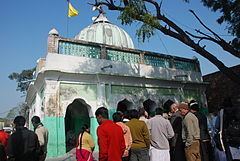Type Memorial | ||
 | ||
Architectural Indo-Islamic architecture Similar Kabuli Bagh Mosque, Ibrahim Lodhi's Tomb, Salar Ganj Gate, Panipat Museum, Sthaneshwar Mahadev Temple | ||
Hemu's Smadhi Sthal, is a memorial to the Hindu king Hemu at Shodapur village on Jind road near Panipat city in Panipat district of Haryana state in India. It stands at the location where he was executed.
Contents
Encrochment
As the structure was lying unattended and in a state of neglect by Haryana Govt. it has been used by the migrant Muslims who have turned it into a Durgah. This property, more than 10 Acres in revenue records, which formed the Camp of Babur in 1526 during First Battle of Panipat and Camp of Akbar in 1556 during Second Battle of Panipat was with Haryana ASI till 1990. Area still has a Water Tank constructed with Lakhori Bricks in diapleted condition built during stay of Babur. The Chief Minister, Mr. OPChautala of Haryana, in 1990 released the entire area to 'Wakf Board of Haryana' whose Chairman, a Muslim MLA from Mewat area of Haryana allowed encrochments charging money from some people and allowed Pucca constructions.
The Samadhi Sthal was constructed by Hemu's supporters during Akbar's rule on the spot where the dead Hem Chandra Vikramaditya was beheaded by Bairam Khan to get a false title of Ghazi for Akbar. Presently a nearby small Mosque and Samadhi Sthal are with Muslim community and rest of all place is illegally encroached with the patronage of Wakf Board. The structure in revenue records is classified as 'Khanghah' in Persian, meaning a 'Serai' or a resting place for travellers. Such Serai's were often constructed by rich in memory of dead specially in Rewari area of Haryana where Hem Chandra belonged to. Haryana Govt.needs to clear the 'Smadhi Sthal' and surroundings from encrochments and convert the area in to a suitable memorial.
Architecture
It is built in Hindu architecture. Several such structures, called 'Chattries' or 'Resting Places' for travellers are found in Rewari area with similar architecture and constructed during last many centuries.
History
Hemu's rise from his humble beginnings in Rewari to the assumption of the royal title of Raja Vikramaditya is considered a notable turning point in history. But for the stray arrow in a battle where he was in a position of strength, Hemu Vikramaditya could well have brought about a restoration of a "Sanskritic/Brahminical monarchical tradition" to a region which had been subject to Muslim rule for centuries.
Colonel H.C. Kar comments: "He assumed the title of Vikramaditya. He emerged as a monarch in his own right and the only Hindu to occupy the throne of Delhi during the medieval history of India. Himself a staunch Hindu, he had no disrespect for any religion, Islam or Christianity". Kar also notes that Hemu's rule was on the pattern of the Vijayanagara Empire, a strong Hindu state prevailing in South India for more than three centuries.
John Clark Marshman wrote in 1873:
The Second Battle of Panipat was fought on 5 November 1556 between the forces of Akbar and Hemu, a Hindu king of Delhi. Hemu had a large army, and initially his forces were winning, but suddenly Hemu was struck by an arrow in the eye and he lost his senses. On not seeing him in his howdah on the back of an elephant, his army fled. The wounded Hemu was captured by Shah Quli Khan Second Battle of Panipat and carried to the Mughal camp at Shodapur on Jind Road at Panipat.
According to Badayuni, Bairam Khan asked Akbar to behead Hemu so that he could earn the title of Ghazi. Akbar replied 'He is already dead, if he had any strength for a duel, I would have killed him'. After Akbar's refusal Hemu's body was denied honour by the Mughal battle tradition and was unceremoniously beheaded by Bairam Khan.
